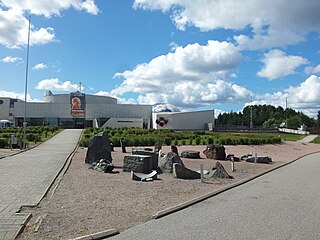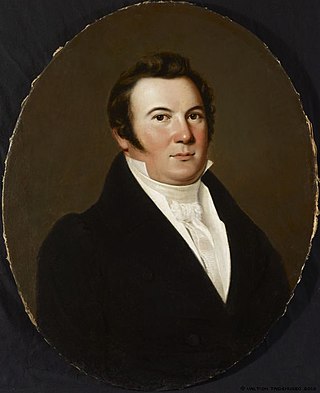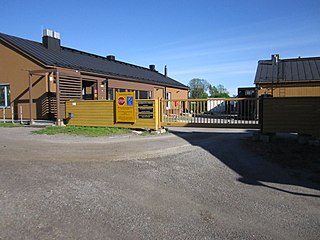
Suomenlinna, or Sveaborg, is an inhabited sea fortress composed of eight islands, of which six have been fortified; it is about 4 km southeast of the city center of Helsinki, the capital of Finland. Suomenlinna is popular with tourists and locals, who enjoy it as a picturesque picnic site. Originally named Sveaborg, or Viapori as referred to by Finnish-speaking Finns, it was renamed in Finnish to Suomenlinna in 1918 for patriotic and nationalistic reasons, though it is still known by its original name in Sweden and by Swedish-speaking Finns. Due to its strategic geographical location, it sometimes used to be known as Gibraltar of the North.

Vuosaari is a neighbourhood in the City of Helsinki, Finland. It is located by the sea in East Helsinki and with its area of 15.38 km2 (5.94 sq mi) is geographically the largest district in the city. It also has two Helsinki Metro stations, Rastila and Vuosaari

Loviisa is a municipality and town of 14,458 inhabitants on the southern coast of Finland. It is located 90 kilometres (56 mi) from Helsinki and 38 kilometres (24 mi) from Porvoo. About 43 per cent of the population is Swedish-speaking.

Katajanokka is a neighbourhood of Helsinki, Finland, with around 4000 inhabitants in 2005. The district is located adjacent to the immediate downtown area, though in the first major town plan for Helsinki from the mid-18th century, the area fell outside the fortifications planned to encircle the city.

Lauttasaari is an island in Helsinki, Finland, about 3 kilometres (1.9 mi) west of the city centre. Together with some surrounding unpopulated small islands, Lauttasaari is also a district of Helsinki. With 23,226 residents as of 2017, the island is Finland's second largest by population, after Fasta Åland. Its land area is 3.85 km2.

Heureka is a Finnish science center in the Tikkurila district of Vantaa, Finland, north of Helsinki, designed by Heikkinen – Komonen Architects. It is located at the intersection of the Finnish Main Line and the river Keravanjoki.

Sörnäinen is a neighbourhood in the city of Helsinki, Finland.

The Suomenlinna Church in Helsinki, Finland, was built in 1854 as an Eastern Orthodox garrison church for the Russian troops stationed at the Suomenlinna sea fortress. The fortress comprises five islands joined together by bridges, and the church is the central feature on the island of Iso Mustasaari, located at its highest point. It is surrounded by other fortress buildings, but the old parade ground is immediately to the east, and a park lies immediately to the south. It is oriented southwest to northeast so that it would align with the Crownwork Ehrensvärd defense front located to the southwest of the church.

Haukilahti is a neighbourhood in Espoo, Finland. It is located on the seashore of the Gulf of Finland in the southern part of the city.

Public transport in Helsinki consists of bus, tram, metro, local railway and ferry services. The system is managed by the Helsinki Regional Transport Authority and covers Helsinki, Espoo, Kauniainen, Vantaa and the outlying Kerava, Kirkkonummi, Sipoo and Tuusula.

Kuivasaari is a Finnish island in the Gulf of Finland, near Helsinki.

The Military Museum of Finland is the central museum of the Finnish Defence Forces and the national special museum of military history. It is located in Helsinki and it is part of the Finnish National Defence University. In 2018, the Military Museum's exhibitions in Suomenlinna had around 131,000 visitors. The most popular exhibition is the submarine Vesikko, visited by around 50,000 people annually. Military Museum's exhibitions in Suomenlinna are located at Manege and Artillery Maneage.

The Krepost Sveaborg was an Imperial Russian system of land and coastal fortifications constructed around Helsinki during the First World War. The purpose of the fortress was to provide a secure naval base for the Russian Baltic fleet and to protect Helsinki and block routes to Saint Petersburg from a possible German invasion. Krepost Sveaborg was part of Peter the Great's Naval Fortress, a coastal fortification system protecting access to Saint Petersburg by sea. The central part of Krepost Sveaborg was the old fortress of Suomenlinna where the fortress headquarters were located. Due to technological advances in artillery the old fortress was no longer capable of providing a sufficient protection, and a new main defensive line was built well beyond the old fortress boundaries. New coastal artillery guns built on outlying islands protected Krepost Sveaborg from the sea, while fortified lines constructed around Helsinki were intended to stop any attacks on land. The primary coastal guns were 10 in (254 mm) model 1891 guns and 6 in (152 mm) model 1892 Canet guns. Older 11 in (279 mm) model 1877 guns were also used. In summer 1917 the fortress had two hundred coastal or anti-landing guns, of which 24 were 10-inch guns in six batteries, 16 were 6-inch Canet guns in four batteries and twelve were 11-inch guns in three batteries. The artillery used in land fortifications included older coastal guns, old fixed carriage guns and newer light field guns. In March 1917, Krepost Sveaborg had a total of 463 guns, although many of them were obsolescent. Krepost Sveaborg was still partly incomplete in 1917 when the February Revolution halted most of the construction work. Some further construction work was carried out during the remaining year, but all work halted during the October Revolution. Following the Finnish Declaration of Independence, parts of the land fortifications were used in the Finnish Civil War. The coastal fortifications were later taken over by Finland to protect Helsinki, while the land fortifications were mostly abandoned and disarmed.

Isosaari is an island in Helsinki, part of the Ulkosaaret district of the city, more specifically of Itäsaaret, i.e. ‘eastern islands’. It was one of the fortified islands of the Gulf of Finland. Isosaari is one of the outermost islands in the Helsinki region, and it is a site that is important from the perspective of cultural history. Its sights and its nature are unique.

Suomenlinna prison camp was a 1918 Civil War of Finland concentration camp in the Suomenlinna Fortress, Helsinki. It was established by the White Army for the Red Guard fighters taken prisoner after the Battle of Helsinki. The camp operated from April 1918 to March 1919. It was a subcamp for the Helsinki prison camp, which included the camps of Suomenlinna, Santahamina, Katajanokka and Isosaari.

Nikolai Sinebrychoff was a Russian businessman settled in Finland, who founded the Sinebrychoff brewery in 1809. He belonged to the Sinebrychoff family which had a long history in Finland.

Lonna is a small island off Helsinki, opposite the Suomenlinna Passenger terminal. The island belongs to the Suomenlinna district. Lonna is about 150 meters long and the distance to the mainland is about 1.5 kilometers.

The Ehrensvärd grave is the final resting place and memorial of Augustin Ehrensvärd, the founder of the Suomenlinna island fortress in Helsinki, Finland, at the Linnanpiha yard on the island of Susisaari in Suomenlinna. Ehrensvärd was buried at the yard in 1783 but the memorial was only completed in its current form in 1805.

Suomenlinna is a village-like district of the city of Helsinki, Finland with about 700 inhabitants. Its best known part is the maritime fortress of Suomenlinna.

The Suomenlinna prison is an open prison in Suomenlinna, Helsinki, Finland, founded in 1971. It was previously known as the Suomenlinna penal colony. The prison is located at the southern tip of the island of Iso-Mustasaari. The prison was founded to help in the repair and restoration work of the Suomenlinna fortress; the prison co-operates with the Governing Body of Suomenlinna belonging to the Finnish Ministry of Education. Prisoners in the open prison, nicknamed Konnala work on weekdays in various jobs all over the island, under supervision. Most particularly they repair the buildings and stonework in Suomenlinna or maintain the scenery.




















